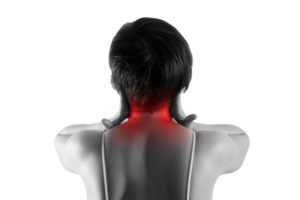Most of us are familiar, at least vaguely, with what it means to have a migraine headache. Occipital neuralgia, however, is another story. This inflammatory condition that affects the occipital nerves at the back of the neck and head is much, much less well-known. The term may be used primarily by physicians who diagnose and treat the underlying causes of chronic migraines. Here, we discuss the symptoms, causes, and solutions for occipital neuralgia.
Symptoms of Occipital Neuralgia

Occipital Neuralgia
Three separate occipital nerves are situated at the back of the head and upper neck. Inflammation in one or more of these nerves can result in severe, even debilitating, pain. Some patients report an odd sensation in the neck and head region accompanied by pain in the face or upper extremities. Occipital neuralgia may also cause dizziness, nausea, vomiting, or ringing in the ears. These symptoms may come and go at irregular intervals.
What Causes Occipital Neuralgia?
Inflammation of the occipital nerves may develop for several different reasons. Most commonly, we see inflammation result from compression of some sort. Compression could be related to a growth or tumor, but this is rare. More often, it is the muscles or fascia that surround these nerves that cause symptoms. Pulsating pain may occur when a nearby blood vessel compresses on an occipital nerve.
Traumatic injury may play a role in the development of occipital neuralgia. This could be a whiplash injury from an auto accident. Whiplash suddenly stretches the nerve and surrounding muscles and connective tissue, which causes immediate swelling and compression. These symptoms may continue long after the original injury.
Diagnosis and Treatment
Occipital neuralgia is often diagnosed when other potential causes of headache pain are ruled out. An innovative diagnostic method used by headache specialists is to administer a nerve block to the affected nerves. A nerve block consists of a local anesthetic injected into one of the occipital nerves at the side of the neck. If the first nerve block reduces pain, a second is administered into another occipital nerve. If further improvement is needed, the third and final occipital nerve may receive an injection. While this technique provides significant relief in itself, it is also used to determine if surgical disruption or decompression of the occipital nerves may improve symptoms.
Inflammation in the occipital nerves is often first treated with medications such as anti-depressants, anti-convulsants, and serotonin inhibitors. Narcotic medications may be considered, though this approach comes with potentially serious disadvantages. An alternative may be to administer Botox injections to decrease muscle constriction around the occipital nerves. Inflammation may also be decreased with steroid injections in the affected area. As a definitive option, a migraine specialist may consider surgical intervention.
Dr. Lowenstein is an established plastic and reconstructive surgeon who has received training from one of the world’s most renowned headache specialists. If you want to gain freedom from chronic headaches or migraines, contact us at 805.969.9004. We are happy to arrange a consultation for you at our Santa Barbara office.

